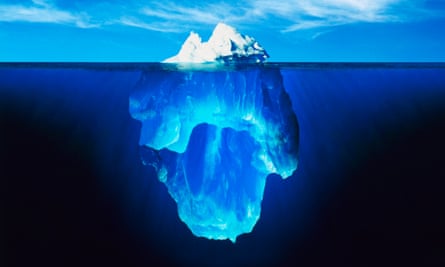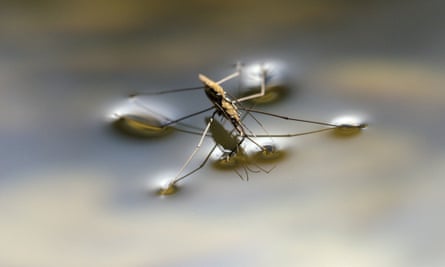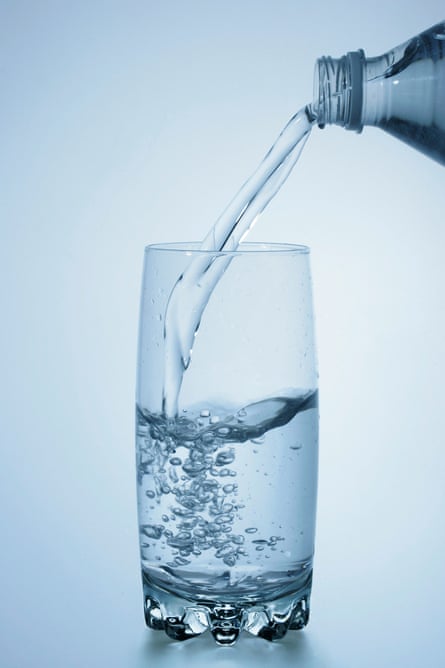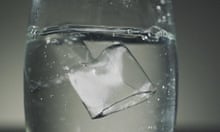Water is the only substance on Earth whose chemical formula has entered the vernacular. We all know H2O, even if we don’t understand precisely what it means. But if it sounds simple, the reality is different. This common, seemingly boring substance baffles and confuses anyone who peers at it for long enough.
Water breaks all the rules. Since the 19th century, chemists have developed a robust framework to describe what liquids are and what they can do. Those ideas are almost useless at explaining the weird behaviour of water. Its strangeness underlies what happens every time you drop an ice cube into a drink. Think about it for a moment: in front of you is a solid, floating on its liquid. Solid wax doesn’t float on melted wax; solid butter doesn’t float on melted butter in a hot saucepan; rocks don’t float on lava when it spews out of a volcano.
Ice floats because water expands when it freezes. If you’ve left a bottle of fizz in the freezer overnight, you’ll know that this expansion is a powerful force: strong enough to shatter glass. This seems like a small and inconsequential curiosity, but this anomaly – one of water’s plethora of strange and unique behaviours – has shaped our planet and the life that exists on it.
Through aeons of cycles of freezing and melting, water has seeped into giant boulders, cracked those rocks apart and broken them up into soil. Ice floats in our drinks, but also across our oceans as sea ice and glittering icebergs. In frozen lakes and rivers, the ice does more than decorate the surface; it insulates the water underneath, keeping it a few degrees above freezing point, even in the harshest of winters.
Water is at its most dense at 4C and, at that temperature, will sink to the bottom of a lake or river. Because bodies of water freeze from the top down, fish, plants and other organisms will almost always have somewhere to survive during seasons of bitter cold, and be able to grow in size and number. Over geological time, this oddity has allowed complex life to survive and evolve despite the Earth’s successive ice ages, periods when fragile life forms would have otherwise been wiped out on the desiccated, frozen ground and – if water behaved like a normal liquid – in solidified seas, too.
This, though, is just the start. Take a glass of water and look at it now. Perhaps the strangest thing about this colourless, odourless liquid is that it is a liquid at all. If water followed the rules, you would see nothing in that glass and our planet would have no oceans at all. All of the water on Earth should exist as only vapour: part of a thick, muggy atmosphere sitting above an inhospitable, bone-dry surface. A water molecule is made from two very light atoms – hydrogen and oxygen – and, at the ambient conditions on the surface of the Earth, it should be a gas. Hydrogen sulphide (H2S), for example, is a gas, even though it is twice the molecular weight of water. Other similar-sized molecules – such as ammonia (NH3) and hydrogen chloride (HCl) – are also gases.

If you thought that was strange, how about this: hot water freezes faster than cold water. It’s a peculiarity known as the Mpemba effect, after a Tanzanian high-school student named Erasto B Mpemba, who found in 1963 that hot ice-cream mix froze faster than a colder mix in a classroom experiment. Though ridiculed by his teacher, Mpemba was not alone in noticing this peculiar effect of water – Aristotle, Francis Bacon and René Descartes have all written about it.
To understand why water bends all the rules, think about how an insect – a water strider, say – can zip along the surface of a pond. It doesn’t fall into the depths because of the water’s surface tension, which is immense when compared with that of other liquids. This comes about because of the intriguing ability of water molecules to stick to each other. In the liquid form, the hydrogen atoms of one water molecule are attracted to the oxygen atom of another molecule. Each water molecule can form up to four of these hydrogen bonds and, collectively, they give water a cohesiveness unique in liquids. This explains why water is a liquid on the surface of the Earth: the hydrogen bonds hold the molecules together in such a way that more energy than normal is needed to separate them, for example if you want to boil the liquid into a gas.

It’s hard to over-emphasise the importance of the hydrogen bonds in water. They enable water molecules to pull each other through the tiniest blood vessels in your body – often working against the force of gravity – carrying oxygen and nutrients to parts that would otherwise be hard to reach. The same mechanism means that plants can suck water up from deep below the Earth’s surface to nourish the leaves and branches that grow in the sunshine.
Water’s stickiness makes possible other everyday phenomena we take for granted: it means we can pump water around the radiators in our homes, squeeze orange juice out of the carton at breakfast, and hose the flowerbeds in our gardens. All these things are possible because water is difficult to compress – the molecules attract each other and, in their natural state, tend to stay closer together than the molecules in other liquids. The harder something is to compress, the easier it is to move it around if you apply a pressure to one side of it. (A liquid being incompressible might not sound too abnormal, but water takes it to different levels – even at a mile deep, the ocean’s water is squashed in volume by only about 1%.)
Water is not only attracted to itself but will stick to almost anything else it comes across. It is the closest thing we have to a universal solvent, able to tear apart other compounds. Common salt, which is made up of crystals of sodium chloride, easily dissolves in water because the hydrogen bonds pull the sodium and chlorine atoms away from the crystal, leaving them to float freely through the liquid. Water is such a good solvent, in fact, that it is almost impossible to find naturally in a pure state; even producing pure samples in the laboratory is difficult. Almost every known chemical compound will dissolve in water to a small (but detectable) extent. Because of that, water is one of the most reactive and corrosive chemicals we know.
That ability to interact with so many things is crucial for life. It means that water can dissolve a wide variety of nutrients and other ingredients and move them around our bodies. The basic molecules of life – DNA, proteins, molecules that make up cell membranes, etc – wouldn’t work without water. Evolution has shaped these long, sophisticated molecules so that they have certain sections that easily mix with water, using hydrogen bonds, and other sections that shun water, like oil refusing to mix. The billions of protein molecules inside your body only fold into the right shapes to do their jobs because their interaction with water nudges them into the correct three-dimensional formats.

Think of a liquid and it will most likely be water. Even if you think of blood, beer or apple juice, you’re thinking of water with a small amount of other things dissolved or suspended within it. There are other pure liquids that appear in everyday life, such as petroleum or cooking oil, but there aren’t many and we do not interact with them anywhere near as frequently. Water is so common and so familiar that it is mundane: every day we drink it, touch it, wash with it, wet things, dry things, we boil it, freeze it and swim in it. We live in a world where the environmental conditions allow us to explore the landscape of water at different temperatures and pressures; where it can slide comfortably between solid, liquid and gas (or sometimes all three at once). The more we examine water, the stranger it gets. We study it because we are made from it, and it is, perhaps, surprising that the thing we are made from is still such a mystery.
Alok Jha is science correspondent for ITV News and author of The Water Book (Headline, £20). To order a copy for £11.99, go to bookshop.theguardian.com or call the Guardian Bookshop on 0330 333 6846. Free UK p&p over £10, online orders only. Phone orders min. p&p of £1.99.




Comments (…)
Sign in or create your Guardian account to join the discussion